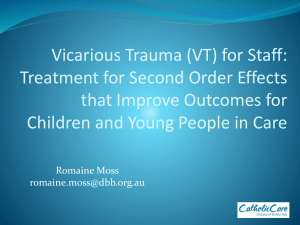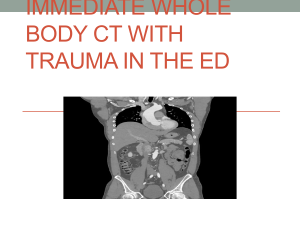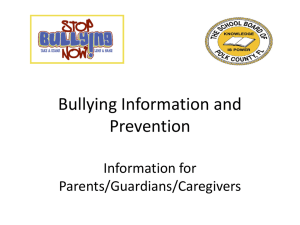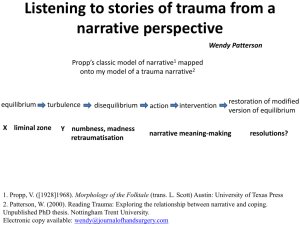Trauma Bullying Final - International Bullying Prevention Association
advertisement
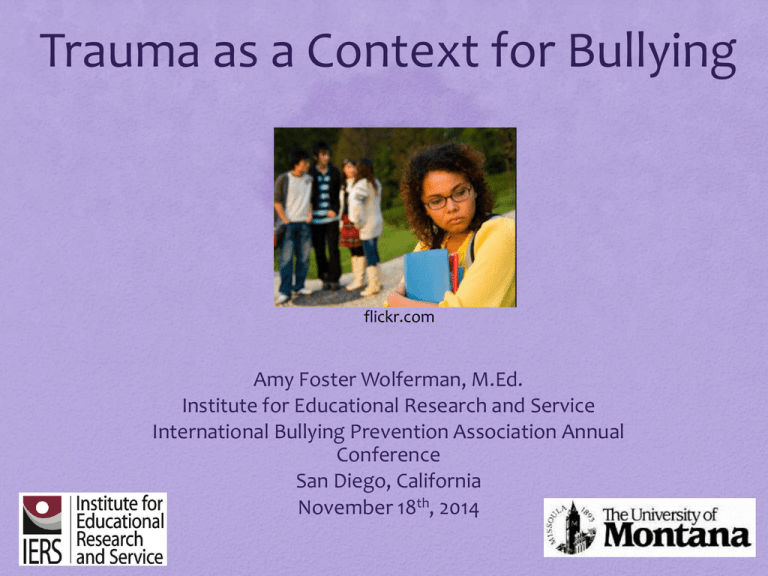
Trauma as a Context for Bullying flickr.com Amy Foster Wolferman, M.Ed. Institute for Educational Research and Service International Bullying Prevention Association Annual Conference San Diego, California November 18th, 2014 www.umt.edu National Native Children’s Trauma Center Established in Fall 2007 to serve as a Treatment and Services Adaptation Center (Cat III) within the National Child Traumatic Stress Network (NCTSN); • Became Category ll Center in 2012 Mission: In respectful partnerships with tribes, NNCTC will implement, adapt, evaluate and disseminate trauma interventions to decrease the social, emotional, spiritual and educational impact traumatic experiences have on American Indian and Alaska Native children. Agenda • Define trauma and PTSD • Discuss the relationship between trauma and bullying • Review the Adverse Childhood Experiences (ACEs) study and how it relates to bullying • Discuss school-based prevention and intervention strategies What is Trauma? • A highly stressful experience which can result in lasting emotional and physical effects • Usually in face of perceived threat to life, physical integrity, caregiver, environment • The 3 E’s (event, experience, effect) • Overwhelms capacity to cope • Fight, Flight, Freeze (SAMHSA, 2014) 5 Trauma Types • Acute Trauma • A single traumatic event that overwhelms a person’s ability to cope • Chronic Trauma • Repeated, ongoing • Complex Trauma • Multiple and/or chronic, most often of an interpersonal nature and early life onset. • These exposures often occur within the child’s care giving system (NCTSN, 2014) A Range of Traumatic Situations • • • • • • Automobile accidents Life-Threatening illness Witnessing or experiencing community violence Natural disasters (tornado, house fire) Terrorism Traumatic death • • • • • • • • Physical, emotional or sexual abuse Abandonment Witnessing domestic violence Bullying Neglect Homelessness Living in a chronically chaotic environment Military deployment 7 Bullying as a Traumatic Experience • Definition of trauma: a highly stressful experience in the face of a perceived threat to one’s self or to one’s physical integrity or to that of one’s family member, close friend, or environment (SAMHSA, 2014) flickr.com • Definition of bullying: repeated and intentional acts of psychological or physical harm involving an imbalance of power (Olweus, 1993) Posttraumatic Stress Disorder • Most of us react to trauma – survival mechanism – symptoms fade over time • PTSD is a distress response experienced after exposure to a traumatic event(s), but it doesn’t go away • Includes specific criteria flickr.com 9 PTSD Criteria • Exposed to a stressor • Intrusion symptoms - re-experiencing • Avoidance symptoms • Negative impact on cognition and mood – changes in affect – dysregulation of emotions • Changes in arousal levels - hyperarousal • May include dissociation - numbing • PTSD subtype for six years and younger DSM V Perceived Triggers of Danger • Reminders of trauma can lead to sudden fear • Sights, smells, sounds • Body’s alarm system - fight/flight/freeze • Adults can unintentionally trigger children through harmless actions Threat Appraisal and Detection in Traumatized Children (Pollack et al., 2000) Bruce Perry – Child Trauma Academy Adaptive Responses to Trauma Rest Vigilance Hyperarousal Rest Continuum Vigilance Freeze Flight Fight Resistance Defiance Aggression Disassociative Rest Avoidance Compliance Dissociation Continuum Mental State Calm Alert Alarm Fear Fainting Terror Bullying and PTSD • Study - students grades 8 and 9 (n=963) – Idsoe, Dyregrov & Idsoe (2012) • For all bullied students, 27.6% of boys and 40.5% of girls had PTSD scores within the clinical range • Those who both bully and are bullied had even worse symptoms • Because bullying is ongoing and typically goes undetected, many children who are bullied can develop symptoms of PTSD (van der Kolk, Weisaeth, & McFarlane, 2007) How Common is Trauma? • 1 out of 4 children who attend school has been exposed to a traumatic event (NCTSN) • Screening results indicate in some communities that 77% of children have been exposed to trauma (Morsette, et al, 2012) Understanding Trauma It begins with the ACE Study The Adverse Childhood Experiences (ACE) Study is one of the largest investigations ever conducted on the links between childhood maltreatment and later-life health and well-being. ACE Study Questions • Did you experience physical abuse? • Did you experience emotional abuse? • Did you experience contact sexual abuse? • Was there an alcoholic or drug-user in your household? • Was there a member of your household imprisoned? • Was there a member of your household that was mentally ill, or did you have a depressed parent or institutionalized family member? • Did you witness your mother being treated violently? • Did you have a biological parent absent from the home? ACEs and Bullying • 41% of children who have had at least 3 ACEs demonstrate negative behaviors like bullying and arguing with their parents. (Sacks, et al., 2014) • As the number of adverse childhood experiences increased, the likelihood of adolescent violence related perpetration (including bullying) also increased. (Duke, et al., 2010) ACEs and Victimization Children who are victims of trauma often have difficulty developing appropriate social skills and are thus more likely to become victims of bullying later in life (Randall, 2002) Characteristics of victims of bullying can overlap with characteristics of children who have been traumatized, e.g. low self confidence, anxiety, fearfulness, sadness, withdrawn, poor social skills. What Can Schools Do? • Create safe places (physically and psychologically) for students to learn • Implement Positive Behavioral Interventions and Supports (PBIS) as framework for bullying prevention and trauma support efforts • Don’t end with stopping bullying – follow up • Screen for trauma symptoms • Integrate tier 1, 2 and 3 level trauma interventions TIER 3 Intensive, Individual Interventions Individual Students; Assessment-based; High Intensity; longer duration 5% 15% TIER 2 Targeted Group Interventions Some students (at-risk) High efficiency Rapid response 80% TIER 1 Core Instructional/ Universal Interventions All students; preventive, proactive PBIS, 2014 Universal Strategies: for ALL students • Build positive, trusting relationships with students and families • Create safe, nurturing environments • Provide consistent, predictable routines • Create clear behavioral expectations • Collect data and monitor • Universal screening • Provide specific, positive feedback • Teach expectations and social skills • healthy coping skills/ resiliency • bullying prevention • Actively supervise • Use consistent consequences that teach and are predictable • Punishment vs Discipline Teaching Social Skills • Bullying Prevention • • • • • • Empathy Assertiveness Friendship skills Emotional regulation Anger management Social problem solving (Committee for Children, 2012) • Trauma Treatment • • • • • • • Affect identification Modulation Affect expression Problem solving Choice making Self development Self identity (Blaustein & Kinniburgh, 2010) ARC Building Blocks Blaustein & Kinniburgh, 2010 Trauma Experience Integration Competency Executive Functions Self Dev’t & Identity Dev’tal Tasks Affect Identification Caregiver Affect Mgmt. Attunement Modulation Consistent Response Affect Expression Routines and Rituals SelfRegulation Attachment Targeted Interventions: for SOME • Intensive social skills instruction • relaxation techniques, coping, anger management, assertiveness, empathy • Check-in/Check-Out program • Mentorship program • Behavior Support Team • Cognitive Behavioral Interventions for Trauma in Schools (CBITS) groups Individualized Interventions: for a FEW • Individualized plans to address individual symptoms (aggression, impulsivity, short attention span, social isolation, etc.)…using…. • Functional Behavioral Assessment • Trauma focused individualized counseling or therapy • Trauma-focused CBT • Behavior support team connects student to counselor or therapist, works with family Supporting Social Competence and Academic Achievement OUTCOMES Supporting Decision Making Supporting Staff Behavior PRACTICES Supporting Student Behavior PBIS, 2014 Some Good News: Resilience • Resilience….the ability to recover from traumatic events...the process of adapting well in the face of adversity, trauma, tragedy, threats or even significant sources of threat (APA) • The natural ability to navigate life well (HeavyRunner & Marshall, 2003) • Research has shown that 2/3 of children who experience adverse childhood events will grow up and “beat the odds” (Michenbaum, n.d.) Resilience Contact Information Amy Foster Wolferman Institute for Educational Research and Service The University of Montana Missoula, Montana (406) 243-5417 amy.fosterwolferman@umontana.edu www.iers.umt.edu/ References and Resources • American Psychological Association (n.d.). FYI: Building Your Resilience. Retrieved November 3, 2014, from http://www.apapracticecentral.org/outreach/building-resilience.aspx • Blaustein & Kinniburgh (2010). Treating Traumatic Stress in Children and Adolescents: How to foster resilience through Attachment, Self-Regulation, and Competency. New York, NY: Guilford Press. • Committee for Children (2012). Bullying Prevention in Schools Starts with Social-Emotional Learning. Retrieved October 10, 2014, from http://www.cfchildren.org/Portals/0/SS_BPU/BPU_DOC/SEL_Bullying_Paper. pdf • DSM-5 Criteria for PTSD. (n.d.). Retrieved October 7, 2014, from http://www.ptsd.va.gov/professional/PTSD-overview/dsm5_criteria_ptsd.asp • Duke, N., Pettingell, S., McMorris, B, & Borowsky, I. (2010). Adolescent Violence Perpetration: Associations with Multiple Types of Adverse Childhood Experiences, Pediatrics, Retrieved October 25, 2014. from pediatrics.aappublications.org/content/125/4/e778.full.html References and Resources • Photographs retrieved from: www.flickr.com • HeavyRunner, I & Marshall, K. “Miracle survivors”: Promoting resilience in Indian students. Tribal College Journal. 2003;14(4):14–19. • Idsoe, T., Dyregrov, A. & Idsoe, E.C. Bullying and PTSD Symptoms, Journal of Abnormal Child Psychology. 2012; 40(6); 901-911. • Michenbaum, D. (n.d.). How Educators Can Nurture Resilience in High-risk Children and their Families. Retrieved September 18, 2014, from www.teachsafeschools.org/resilience.pdf • Morsette, A., van den Pol, R., Schuldberg, D., Swaney, G., & Stolle, D. (2012). Cognitive behavioral treatment for trauma symptoms in American Indian youth: Preliminary findings and issues in evidence-based practice and reservation culture. Advances in School Mental Health Promotion, 5(1), 51-62. References and Resources • National Child Traumatic Stress Network, www.nctsn.org • Olweus, D. (1993). Bullying at school: What we know and what we can do. Malden, MA: Blackwell Publishing • Pollack, S., Cicchetti, D., Hornung, K. & Reed, A. Recognizing Emotion in Faces: Developmental effects of child abuse and neglect. Developmental Psychology (2000); 36 (5): 679-688. • Randall, P. (2002). Bullying in Adulthood: Assessing the Bullies and their Victims. New York, NY: Taylor and Francis, Inc. • Sacks, V., Murphey, D., & Moore, K. (2014). Adverse Childhood Experiences: National and State Level Prevalence. Research Briefs. Retrieved October 10, 2014, from http://www.childtrends.org/wp-content/uploads/2014/07/Briefadverse-childhood-experiences_FINAL.pdf References and Resources • Positive Behavioral Interventions and Supports, Office of Special Education Programs, www.pbis.org • Substance Abuse and Mental Health Services Administration. SAMHSA’s Concept of Trauma and Guidance for a Trauma-Informed Approach. HHS Publication No. (SMA) 14-4884. Rockville, MD: Substance Abuse and Mental Health Services Administration, 2014. • The Adverse Childhood Experiences Study, www.acestudy.org • Thorman, I., A, D., & E, I. (2012). Bullying and PTSD Symptoms. Journal of Abnormal Child Psychology, 40(6), 901-911. • van der Kolk, B. A., Weisaeth, A. C., & McFarlane, L. (2007). Traumatic stress: The effects of overwhelming experience on mind, body, and society. New York: The Guildford Press.


